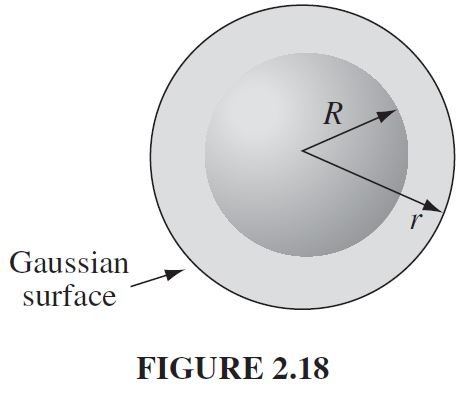Find the field outside a uniformly charged solid sphere of radius R and total charge q.
Question 2.3: Find the field outside a uniformly charged solid sphere of r...
The Blue Check Mark means that this solution has been answered and checked by an expert. This guarantees that the final answer is accurate.
Learn more on how we answer questions.
Learn more on how we answer questions.
Imagine a spherical surface at radius r > R (Fig. 2.18); this is called a Gaussian surface in the trade. Gauss’s law says that
\oint\limits_{S}^{}{E.da}=\frac{1}{\varepsilon _{0}}Q_{enc},and in this case Q_{enc} = q. At first glance this doesn’t seem to get us very far,
because the quantity we want (E) is buried inside the surface integral. Luckily,symmetry allows us to extract E from under the integral sign: E certainly points radially outward,^{5} as does da, so we can drop the dot product,
and the magnitude of E is constant over the Gaussian surface, so it comes outside the integral:
\int\limits_{S}^{}{\left|E\right| .da}=\left|E\right|\int\limits_{S}^{}{da}=\left|E\right|4\pi r^{2} ,Thus
\left|E\right|4\pi r^{2}=\frac{1}{\varepsilon _{0}}q ,or
E=\frac{1}{4\pi \epsilon_{0} }\frac{q}{r^{2}}\hat{r}Notice a remarkable feature of this result: The field outside the sphere is exactly
the same as it would have been if all the charge had been concentrated at the
center.

Related Answered Questions
This is the same problem we solved in Ex. 2.7, but...
The simplest method is to chop the line into symme...
Let E_{1} be the field of the left ...
Place charge +Q on the inner sphere, and −Q on the...
If we put +Q on the top and −Q on the bottom, they...
1
Use Eq. 2.43, in the version appropriate to surf...
From Gauss’s law, the field outside is
E=\f...
Draw a “Gaussian pillbox,” extending equal distanc...